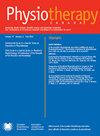Identifying Relevant Content to Inform a Comprehensive Indigenous Health Curriculum: A Scoping Review
IF 0.8
4区 医学
Q4 REHABILITATION
引用次数: 0
Abstract
Purpose: To identify the entry-level curricular content related to Indigenous health recommended for entry-level physiotherapy (PT) programs in Canada and other similar countries. Methods: Design: Scoping review. Procedures: Four electronic databases were searched using the terms physiotherapy, Indigenous health, entry-level curriculum, and their derivatives. Grey literature sources were hand searched and included Canadian PT professional documents, PT Program websites, Truth and Reconciliation Commission (TRC) sources, and a Google search. Data related to curriculum characteristics, methods of delivery, and barriers and facilitators to implementation were extracted from relevant references. Stakeholders reviewed study findings. Results: Forty-five documents were included. Documents focused on Indigenous peoples in Canada, Aboriginal and Torres Strait Islanders in Australia, and Māori in New Zealand. Canadian PT programs appeared to rely on passive teaching methods while programs in Australia and New Zealand emphasized the importance of partnering and engaging with Indigenous people. Barriers to incorporating indigenous health curriculum included an overcrowded curriculum and difficulty establishing relevance of Indigenous content (i.e., meaning). Conclusions: Similarities and differences were found between curricula content and approaches to teaching IH in Canada and the other countries reviewed. Strategies to promote greater engagement of Indigenous people in the development and teaching of IH is recommended.确定相关内容,为土著人健康综合课程提供信息:范围审查
目的:确定与加拿大和其他类似国家入门级物理治疗(PT)项目推荐的土著健康相关的入门级课程内容。方法:设计:范围审查。程序:使用物理治疗、土著保健、入门级课程及其衍生词搜索了四个电子数据库。灰色文献来源是手工搜索的,包括加拿大PT专业文件、PT项目网站、真相与和解委员会(TRC)的资料和谷歌搜索。从相关文献中提取与课程特征、交付方法、实施障碍和促进因素相关的数据。利益相关者回顾了研究结果。结果:纳入文献45篇。文件的重点是加拿大的土著人民、澳大利亚的土著和托雷斯海峡岛民以及新西兰的Māori。加拿大的体育项目似乎依赖于被动的教学方法,而澳大利亚和新西兰的项目则强调与土著人民合作和参与的重要性。纳入土著保健课程的障碍包括课程过于拥挤和难以确定土著内容的相关性(即意义)。结论:加拿大和其他国家的IH课程内容和教学方法存在异同。建议采取战略促进土著人民更多地参与卫生保健的发展和教学。
本文章由计算机程序翻译,如有差异,请以英文原文为准。
求助全文
约1分钟内获得全文
求助全文
来源期刊

Physiotherapy Canada
REHABILITATION-
CiteScore
1.90
自引率
20.00%
发文量
93
审稿时长
>12 weeks
期刊介绍:
Physiotherapy Canada is the official, scholarly, refereed journal of the Canadian Physiotherapy Association (CPA), giving direction to excellence in clinical science and reasoning, knowledge translation, therapeutic skills and patient-centred care.
Founded in 1923, Physiotherapy Canada meets the diverse needs of national and international readers and serves as a key repository of inquiries, evidence and advances in the practice of physiotherapy.
Physiotherapy Canada publishes the results of qualitative and quantitative research including systematic reviews, meta analyses, meta syntheses, public/health policy research, clinical practice guidelines, and case reports. Key messages, clinical commentaries, brief reports and book reviews support knowledge translation to clinical practice.
In addition to delivering authoritative, original scientific articles and reports of significant clinical studies, Physiotherapy Canada’s editorials and abstracts are presented in both English and French, expanding the journal’s reach nationally and internationally. Key messages form an integral part of each research article, providing a succinct summary for readers of all levels. This approach also allows readers to quickly get a feel for ‘what is already known’ and ‘what this study adds to’ the subject.
Clinician’s commentaries for key articles assist in bridging research and practice by discussing the article’s impact at the clinical level. The journal also features special themed series which bring readers up to date research supporting evidence-informed practice.
The Canadian Physiotherapy Association (CPA) is the national professional association representing almost 15,000 members distributed throughout all provinces and territories. CPA’s mission is to provide leadership and direction to the physiotherapy profession, foster excellence in practice, education and research, and promote high standards of health in Canada.
 求助内容:
求助内容: 应助结果提醒方式:
应助结果提醒方式:


